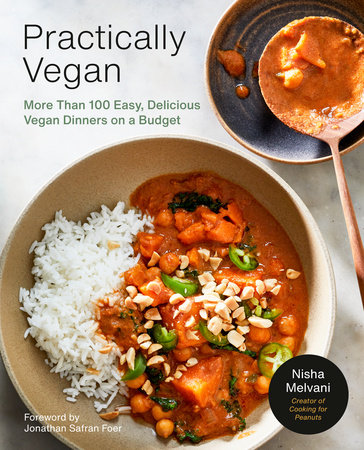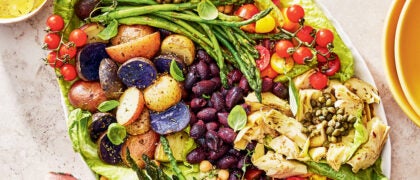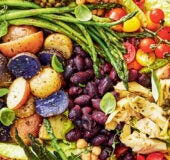The Cook Behind the BookI tried to get out of writing this chapter. I told my editor, “They’re here for the food. They don’t want to know about me!” It turns out this chapter was non-negotiable. So, if you are here for just the food, that’s totally cool. Skip ahead to Pantry Staples on page 15. That one you must read.
I’m trying to resist using the cliché “I always loved to cook.” But the thing is, I really did always love to cook, just like I loved to sew and play the piano—I sound like one of those eighteenth-century girls being primed for marriage. My story, however, is anything but romantic.
I was born and raised on the island of Jamaica by two full-time working parents. So, in reality, they didn’t really do much of the raising. It was Paulette, my awesome nanny, with whom I spent most of my time. She and I were very close, but she took no prisoners. If I was out of line, I was in big trouble. And I rarely toed the line.
It was a challenge for her to manage me. I was a capricious kid, very naughty, always wanting to try something new. Which explains why piano and sewing were eventually replaced by new ventures deemed far more interesting at the time. But cooking, that I never really did quit. Some part of me couldn’t relinquish the challenge of transforming something as mundane as white flour into a delicious, crispy pizza.
My parents didn’t cook. My mom ate because she had to. Her default foods were SPAM and “bun and cheese,” a Jamaican specialty where the bun is a dried-fruit-spiced loaf, and the cheese is packaged as Tastee Cheese. I never saw my mom eat a fruit or vegetable, besides the occasional banana and the many sides of french fries. She recently had one foot of her colon removed because it was so damaged. I’m 100 percent sure it was 100 percent caused by her no-fiber diet, though she will never admit it.
My grandma was the best cook I’ve ever known. She was constantly humming Bob Marley tunes while cooking. Her veggie dishes were so delicious that I could never understand how it was my mother did not like vegetables.
My dad’s dietary choices couldn’t have been more different from my mother’s. Not only did he embrace fruit and vegetables, but he even ate the skins of fruit that aren’t designed to be eaten. Like banana peels. He still literally eats bananas without peeling them. I tried to explain that it’s called the peel for a reason. My kids think this is the best party trick ever.
Our home meals brought these two conflicting perspectives about food to the table. There were a lot of Chef Boyardee ravioli dinners, as well as from-scratch mutton curries. (My parents are both Indian, and so curries were a mainstay for dinner.) While it’s not ideal to be raised on canned foods, having been exposed to these two extremes resulted in giving me a balanced perspective about how food can mean such different things to different people.
My palate became even more diverse when I was sent off to British boarding school at age seven. It was the
Oliver Twist kind of boarding school—one where you were made to pull your socks up and were beaten (albeit gently) for crimes you never committed. Boarding school meals always had meat. A lot of meat. Meat dishes previously unfamiliar to me: steak and kidney pie, shepherd’s pie, cottage pie, liver, haggis, roast lamb, lamb chops, bangers and mash, pigs in a blanket, fish and chips. There were also lots of veggies but I wasn’t such a fan, as they tended to be overcooked until they were mush. Think overboiled Brussels sprouts and green beans like someone forgot they were still on the stove. (Maybe this is why I became so motivated to make veggies irresistibly delicious.) The food was so bad that we even had a rhyme about it. Sung to the tune of “Frère Jacques,” it went like this:
School dinners, school dinners,
Mushy peas, mushy peas,
Soggy semolina, soggy semolina,
Doctor quick, I feel sick,
It’s too late, dunnit on the plate!
Oh, and if you really, really couldn’t eat something, you had to bring in a note from your parents requesting that you be excused from eating that food. You were allowed to cancel two foods—and no more. I’m assuming everyone’s canceled food was some sort of vegetable, given how disgustingly they were prepared. My choices were beets and Brussels sprouts.
And then there was Montreal, where I went to college and enjoyed delicious French food. This didn’t happen all too often given my limited budget as a student, but whenever I had extra money at the end of the month, I would use it to eat in some fancy French restaurant and then try to re-create those gastronomic delights in my dorm kitchen.
After graduating from college and two very short careers (if you can even call them that), one as an investment banker on Wall Street and the other as a secondgrade teacher at a New York City private school, I found my way to Columbia University, where I completed a master’s degree in nutrition, while I also gave birth to three kids in three and a half years. It was at this point that I became focused on raising healthy children who would love vegetables. But I wasn’t confident in my cooking skills and wanted to get better at making creative food. And so, when my kids were old enough to brush their own teeth and wipe their own butts, I signed up for full-time culinary school at the Natural Gourmet Institute, where I spent six months cooking vegan and vegetarian recipes.
Armed with the skills and knowledge I needed, I was now on a mission to make tempeh, the least palatable vegan protein in my opinion, utterly delicious. I am happy to say that my now teenagers are adventurous eaters who enjoy eating plants. I have, over time, learned how to make veggies, tofu, tempeh, beans, lentils—you name it—palatable to children and adults alike, without spending hours in the kitchen, and for cheap.
It was from a want of sharing these ideas with others that I started my Instagram feed, cookingforpeanuts. The success of this feed made me realize how many people are interested in eating this way, and so, when my friend Jonathan Safran Foer suggested I write a cookbook, I went for it.
I set out to create a cookbook filled with vegan dinners that everyone would enjoy with limited, easy-to-find ingredients. Every recipe should be inexpensive, simple, and practical. But they should also use quality ingredients and be sophisticated in their own right.
After making these recipes over and over again, you will become culinary chemists, meaning you will feel confident experimenting with ingredients you have on hand to spontaneously create your own delicious recipes. Plant-based cooking will no longer feel intimidating. Quite the opposite. It will seem ridiculously easy.
I assure you that this book is neither about trying to convince you to become vegan nor about ostracizing those of you who enjoy eating meat. It’s really a guide for those who are trying to eat more plant-based meals and are looking for nonintimidating recipes that are flavorful with affordable, pantry-friendly ingredients that are used over and over again and not left to gather dust on your shelves.
I hope you enjoy making these recipes as much as I enjoyed creating them. Good luck on your plant-based journey.
Nisha
Copyright © 2022 by Nisha Melvani. All rights reserved. No part of this excerpt may be reproduced or reprinted without permission in writing from the publisher.







